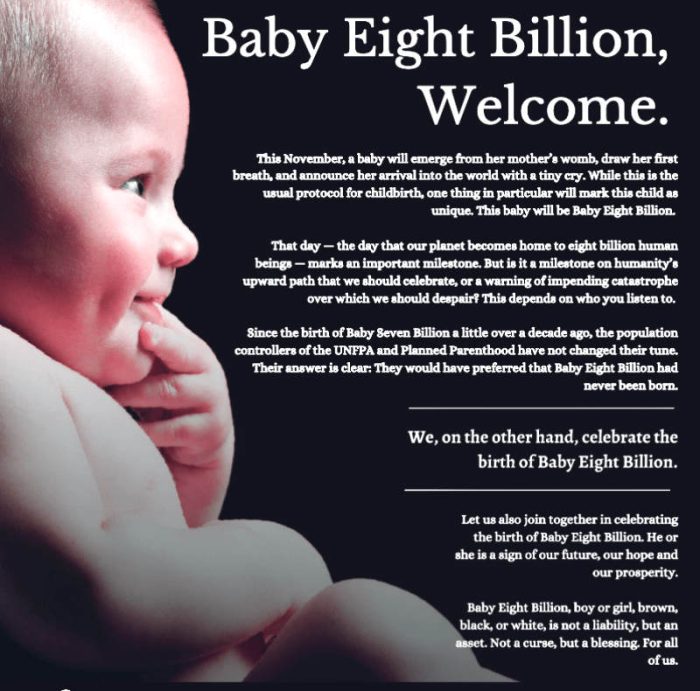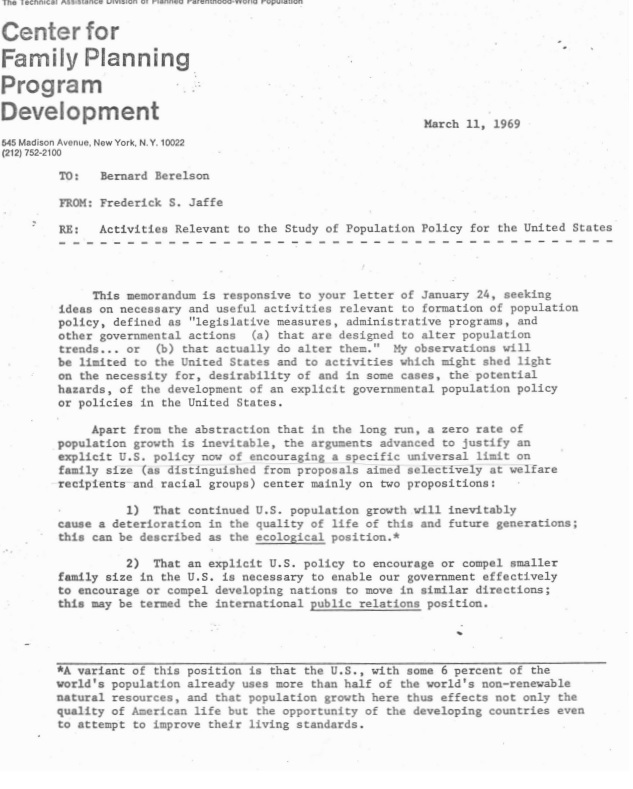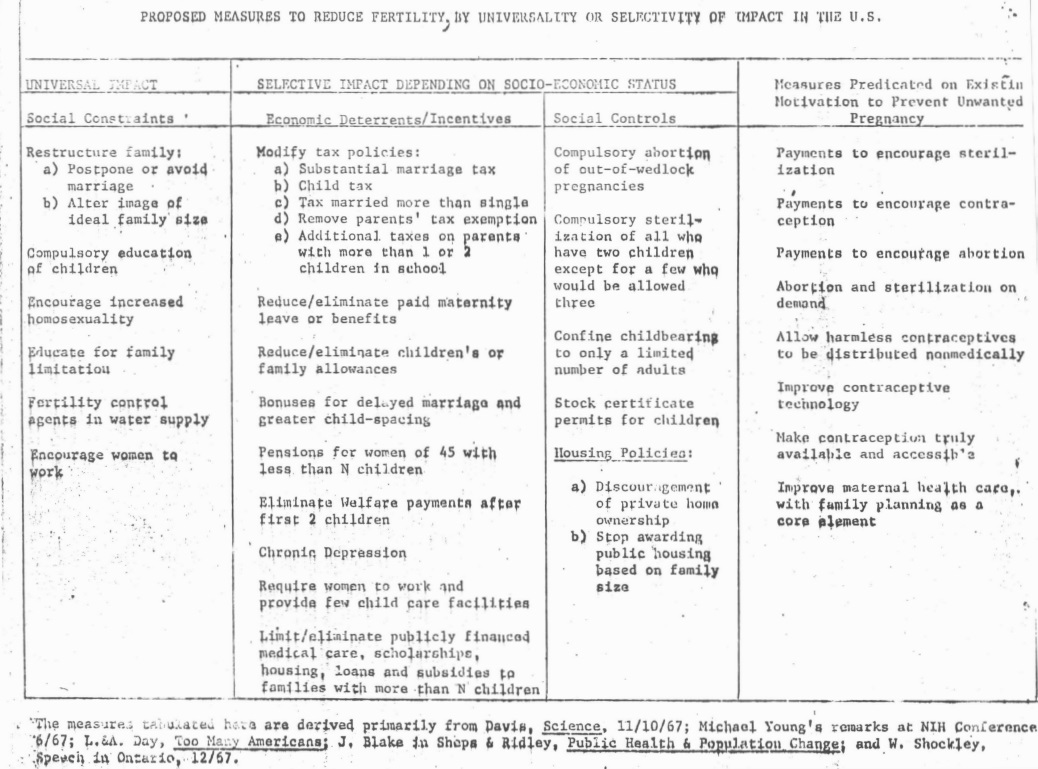Global population has now reached eight billion people, a lower number than what has been predicted in past years, easing some alarmists’ fears about overpopulation. As Live Action News previously documented, the impending global disaster may actually be declining fertility rates and a shrinking human population.
“The world is about to pass a major milestone, as the human population hits 8 billion for the first time. Coming just 11 years after the human population hit 7 billion, it might seem as if the number of people in the world is growing faster than ever,” New Scientist wrote.
But it isn’t, they noted. “The growth rate is plummeting, with fertility rates now below the amount required to maintain a population in most of the world,” they wrote. “It now looks as if the global population will peak by the 2080s.”

Ad in Washington Times sponsored by Live Action and other pro-life groups
“The latest projections by the United Nations suggest that the world’s population could grow to around 8.5 billion in 2030 and 9.7 billion in 2050. It is projected to reach a peak of around 10.4 billion people during the 2080s and to remain at that level until 2100,” UN.org reported.
“The global population is projected to reach 8 billion on 15 November 2022, and India is projected to surpass China as the world’s most populous country in 2023,” the UN added, while claiming that “fertility has fallen markedly in recent decades for many countries. Today, two-thirds of the global population lives in a country or area where lifetime fertility is below 2.1 births per woman, roughly the level required for zero growth in the long run for a population with low mortality.”
The number is less than previously predicted
In 2020, the BBC analyzed a Lancet study on population predictions, writing, “As a result, the researchers expect the number of people on the planet to peak at 9.7 billion around 2064, before falling down to 8.8 billion by the end of the century.”
“Previous versions of the UN World Population Prospects showed a significant slowdown in population growth, with very slow growth – almost reaching a plateau – by the end of the century. In its previous release, it projected that the world population would be around 10.88 billion in 2100, and would not yet have peaked. In this new release, the UN projects that the global population will peak before the end of the century – in 2086 at just over 10.4 billion people,” Our world in Data wrote in July 2022.
Population growth fears
Paul Ehrlich’s 1968 book “The Population Bomb“ predicted that by the 1970s, the world would “undergo famines” and “hundreds of millions of people [would] starve to death.” Ehrlich also falsely predicted that by the 1980s, most of the world’s key natural resources would be depleted, that 65 million Americans would die of starvation between 1980-89, and that by 1999 “the population of the U.S. [would] shrink from 250 million to about 22.5 million … because of famine and global warming.”
Population Council president Bernard Berelson penned a frightening proposal in February of 1969, entitled “Beyond Family Planning” published by the Council’s journal, “Studies in Family Planning.” There he proposed the use of coercive measures should “voluntary means” of family planning be insufficient to reduce population growth.
These included “mass use of fertility control agent[s]” in water supplies, a “license” to have children, “temporary” and “compulsory sterilizations,” “family planning and sex education” in the schools, incentivizing “contraceptive couples” or “couples not bearing children” with monetary payments, taxing births and withdrawing benefits for those who give birth, “direct manipulation of family structure,” and the decriminalization of abortion.
The following month (March 1969), a reply to Berelson sent by former Planned Parenthood VP Fredrick Jaffe also detailed coercive proposals to advance population control. In 1968, Jaffe founded the Center for Family Planning Program Development where he drafted his response. That organization, funded in part by the Rockefeller Foundation, was later renamed the Guttmacher Institute (Planned Parenthood’s now former research arm).

Center for Family Planning Program Development Jaffe Memo response to Bernard Berelson
“Since the U.S. has the resources to make truly efficient contraception truly available to everyone and to complement this with abortion on demand, it could thus provide a test of the uses and limits of voluntary action in solving the population problem,” Jaffe wrote. “The attached table attempts a rough sorting of the principal measures discussed, according to whether their impact would be universal or selective.”
That table, otherwise known as the Jaffe Memo (see below), includes some shocking coercive proposals, much like what Berelson had published.

Jaffe Memo tables includes coercive population control proposals proposed by former Planned Parenthood VP Fredrick Jaffe co-founder of Guttmacher Institute
“Clearly policies which are primarily economic in effect — tax policies, incentives and disincentives — cannot be expected to have equal influence on the behavior of rich middle-class and low-income families,” Jaffe also wrote, “Other proposals — e.g., compulsory abortion of out-of-wedlock pregnancies — can be expected to be applied selectively against those out-of-wedlock pregnancies which are visible and this has racial overtones. Social stratification thus raises sharply the issue, ‘Who shall decide whose fertility – and for whose purposes?'”
United States data
Despite alarmist fears, according to several sources, the U.S. population has already reached over 335 million, and more recently the birth rate has ticked up slightly following years of decline. This increase followed a high number of pregnancy terminations reported in 2020, where tragically 1 in 5 pregnancies ended in abortion, according to Guttmacher.
“The number of births in the United States rose 1% from 2020 to 2021, following a decline of 4% from 2019 to 2020,” the Centers for Disease Control and Prevention (CDC) reported in August. “The general fertility rate, which declined 4% from 2019 to 2020, also rose 1%, from 55.7 births per 1,000 females aged 15–44 in 2020 to 56.3 in 2021.”
A National Bureau of Economic Research working paper, co-authored by Northwestern University economist Hannes Schwandt, attempted to explain the change. According to Northwestern Now, “Many of the women who had babies in 2021 were college-educated, and may have benefited from increased flexibility in their work schedules and more time working from home… Women who were not college educated and some other subgroups continued to see declining birth rates, in keeping with pre-pandemic trends. Schwandt said that thinking comprehensively about how people make the decision to have a baby — largely, an economic decision — could be a good idea for policymakers.”
Unfortunately, as Observer.com noted, the 2021 increase will not be enough to “turn the tide.”
“For the nation’s population to reproduce itself, the ‘total fertility rate’ needs to be at least 2,100 births per 1,000 women, or just over two children for every woman, according to the Centers for Disease Control and Prevention. In 2021 the rate was 1,663 births per 1,000 women, 1 percent more than the previous year, but still too few babies being born to keep the population stable, according to the CDC statistics,” the media outlet wrote. “If the trend isn’t halted, by 2035 the proportion of people over 65 will be greater than those under 18, according to a 2018 report from the US Census.”
Peak of human population
Wall Street Journal columnist Josh Zumbrun warned that the falling global birth rate could quickly usher in the “peak human population.”
“But as we cross eight billion people, it is worth considering that the world might never make it to 10 billion, or even nine billion, and that the world’s major demographic problems won’t stem from the growing masses but from shrinking countries, aging populations and dwindling workforces,” he wrote. “We aren’t talking about meteor strikes, alien invasions or apocalyptic scenarios (though, of course, that could do it, too) but rather straightforward demographic projections that conclude that birthrates have been falling so rapidly around the world that we could potentially reach the peak of human population in less than a generation.”
Some people, however, don’t seem alarmed at all at the idea of eventual societal and economic collapse.
“For many futurists, the primary challenge posed by declining population growth is economic: When people live longer and have fewer babies, the population ages, leaving fewer working-age adults to support a country’s swelling number of retirees,” writes Spencer Bokat-Lindell at the New York Times (NYTs).
But, he added, “For some demographers, the prospect of population stagnation or decline isn’t any more a cause for alarm than population growth was; it’s simply a change that governments will need to manage.”








